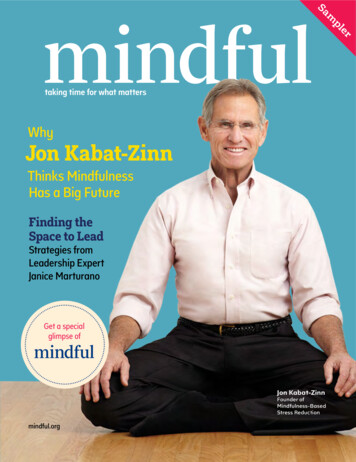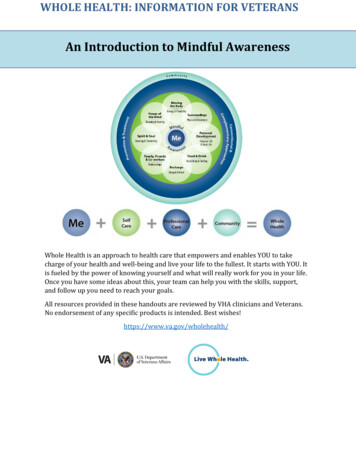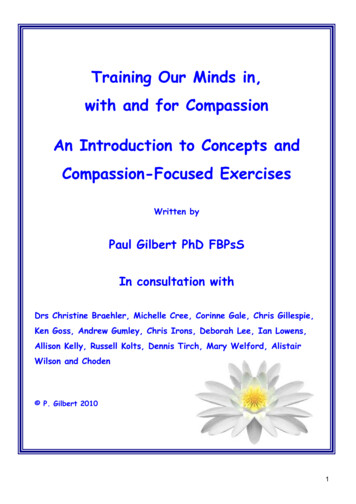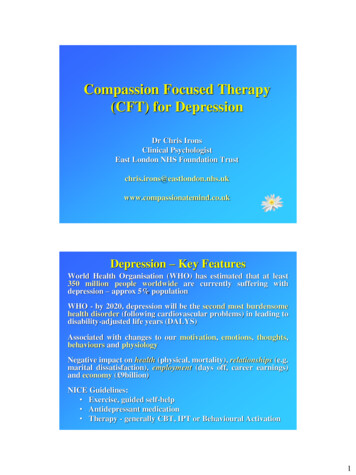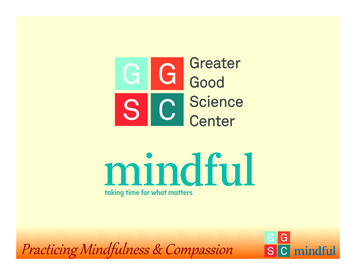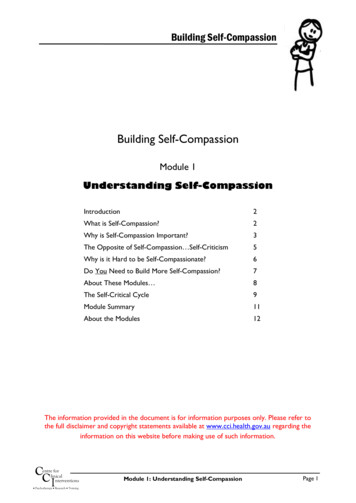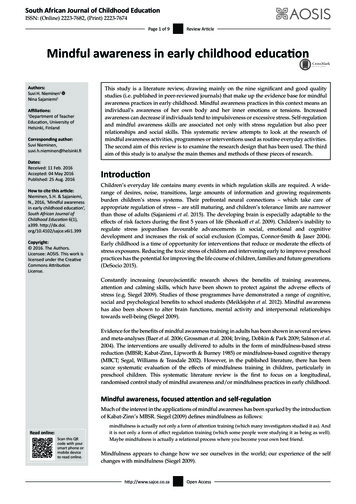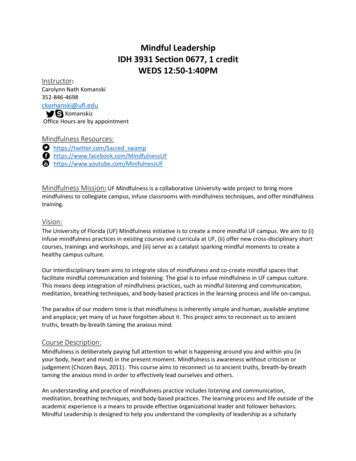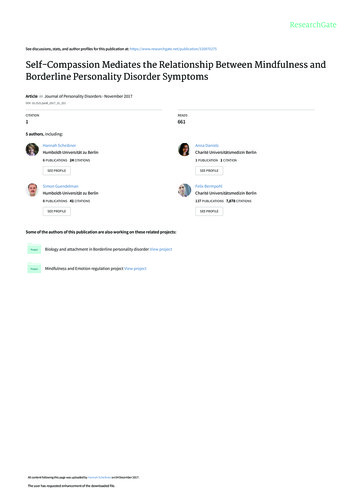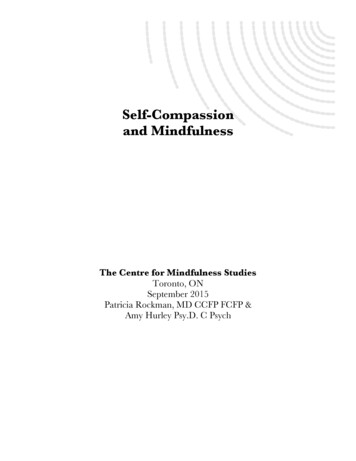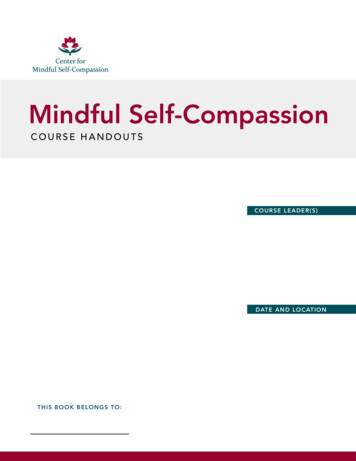
Transcription
Mindful Self-CompassionCOURSE HANDOUTSCOURSE LEADER(S)DATE AND LOCATIONTHIS BOOK BELONGS TO:
Christopher Germer & Kristin Neff (2019).Mindful Self-Compassion Handout Booklet.San Diego, CA: Center for Mindful Self-Compassion.All rights reserved. This booklet is for copying and distributing toparticipants in MSC classes. If anyone would like permission toreproduce, distribute, publish, display, or modify these materials forother purposes, please contact www.centerformsc.orgM I N D F U L S E L F - C O M PA S S I O N H A N D O U T B O O K L E Tii
TABLE OF CONTENTSMSC Workbook .1Definitions.2The Science of Self-Compassion.3References.5Pathways and Stages.6MSC Session Outline.7Home practice.9What Works for Me?.10Backdraft.11MSC Weekly Feedback .13Staying connected.14M I N D F U L S E L F - C O M PA S S I O N H A N D O U T B O O K L E Tiii
MSC WORKBOOKPublished in 2018, The Mindful Self-Compassion Workbook (Neff & Germer) wasdesigned as a companion to the MSC course and to introduce the general public toMSC. It includes much of the theory and practices taught in MSC, plus additionalmaterial on research and special topics.The workbook is highly recommended for MSC participants to:supplement what is learned in classreduce the need to take noteshelp prepare for classreview a missed sessionsupport home practiceThe workbook also contains writing exercises for home study, and vivid stories ofpeople using the techniques to address relationship stress, weight and body imageissues, health concerns, anxiety, and other common problems. People who purchasethe book have access to recorded meditations from the publisher’s 9M I N D F U L S E L F - C O M PA S S I O N H A N D O U T B O O K L E T1
PAGE TITLEDEFINITIONSMindfulness“The awareness that emerges through paying attention on purpose,in the present moment, and nonjudgmentally to the unfolding ofexperience moment to moment.”Jon Kabat-Zinn“Awareness, of the present moment, with acceptance.”Chris GermerAcceptance“Active, nonjudgmental embracing of experience in the here and now.”Steven HayesEmpathy“An accurate understanding of the [another’s] world as seen from theinside. To sense [another person’s] world as if it were your own.”Carl RogersLoving-Kindness“The wish that all sentient beings may be happy.”Dalai LamaCompassion“The wish that all sentient beings may be free from suffering.”Dalai Lama“Deep awareness of the suffering of oneself and other living beings,coupled with the wish and effort to alleviate it.”Paul GilbertSelf-Compassion“When we suffer, caring for ourselves as we would care for someone wetruly love. Self-compassion includes: self-kindness, a sense of commonhumanity, and mindfulness.”M I N D F U L S E L F - C O M PA S S I O N H A N D O U T B O O K L E T2Kristin Neff
TITLETHE SCIENCEPAGEOF SELF-COMPASSIONThe three components of self-compassionResearch on self-compassion(Neff, 2003b)Explosion of research into self-compassionover the past decadeSelf-Kindness vs. Self-Judgment: Treating self with care and understandingrather than harsh judgment Actively soothing and comforting oneselfMost research conducted with theSelf-Compassion Scale (Neff, 2003a)Common humanity vs. Isolation Seeing own experience as part of largerhuman experience not isolating orabnormal Recognizing that life is imperfect (us too!)Self-compassion linked to wellbeing(Zessin, Dickhauser & Garbadee, 2015)Reductions in negative mind-states: Anxiety,depression, stress, rumination, thoughtsuppression, perfectionism, shameMindfulness vs. Over-identification Allows us to “be” with painful feelings asthey are Avoids extremes of suppressing or runningaway with painful feelingsIncreases in positive mind-states: Lifesatisfaction, happiness, connectedness, selfconfidence, optimism, curiosity, gratitudeSelf-compassion leads to wellbeing byholding negative thoughts and emotions inloving, connected, presenceYin and Yang of Self-CompassionYIN - “being with” ourselves in acompassionate way—comforting, soothing,validatingSelf-compassion vs. self-esteem(Neff & Vonk, 2009)YANG - “acting in the world” in acompassionate way—protecting, providing,and motivatingOffers same wellbeing benefits withoutpitfallsFewer social comparisonsLess contingent self-worthNo association with narcissismPhysiological underpinnings (Gilbert, 2009)Physiological underpinnings of self-criticism Threat defense system Cortisol and adrenalineFive main misgivings about self-compassionIs a form of self-pityMeans weaknessWill undermine motivationWill lead to self-indulgenceIs selfishPhysiological underpinnings ofself-compassion Mammalian care-giving system Oxytocin and opiatesM I N D F U L S E L F - C O M PA S S I O N H A N D O U T B O O K L E T3
THE SCIENCE OF SELF-COMPASSIONIs less self-focusedLinked to more other-focused concernLinked to less rumination and selfconsciousness (Raes, 2010; Neff & Vonk,2003a)More caring and supportive relationshipbehavior (Neff & Beretvas, 2013)Less controlling and verbally aggressiveLinked to more connectedness (Neff, 2003a)More forgiveness and perspective taking(Neff & Pommier, 2013)Linked to coping and resilienceEarly influences on self-compassionMore effective coping with divorce(Sbarra et al., 2012)Secure versus insecure attachment(Wei, Liao, Ku & Shaffer, 2011)Less likely to develop PTSD after combattrauma (Hiraoka et al., 2015)Parental criticism and family conflict(Neff & McGehee, 2010)Better coping with chronic health conditions(Sirois, 2015)Linked to motivationHistory of sexual, emotional, physical abuse(Vetesse et al., 2011)(Breines & Chen, 2012)Mindful Self-CompassionLess fear of failure, more likely to try againand persist in efforts after failure(MSC; Neff & Germer, 2013)More personal responsibility and motivationto repair past mistakes8-week workshop (2.5 hours each session)designed to explicitly teach self-compassionEmpirically demonstrated to increase selfcompassion, mindfulness, wellbeingLinked to healthier behaviors (Terry & Leary, 2011)More exercise, more doctors visits, safer sex,less alcohol useAn empirically supported teen adaptationexists called Making Friends with Yourself(Bluth et al., 2015)M I N D F U L S E L F - C O M PA S S I O N H A N D O U T B O O K L E T4
REFERENCESBluth, K., Gaylord, S. A., Campo, R. A., Mullarkey, M. C., & Hobbs, L. (2015). Making Friends with Yourself:A Mixed Methods Pilot Study of a Mindful Self-Compassion Program for Adolescents. Mindfulness,1-14.Braun, T. D., Park, C. L., & Gorin, A. (2016). Self-compassion, body image, and disordered eating: A review ofthe literature. Body Image, 17, 117-131.Breines, J. G., & Chen, S. (2012). Self-compassion increases self-improvement motivation. Personality andSocial Psychology Bulletin, 38(9), 1133-1143.Hiraoka, R., Meyer, E.C., Kimbrel, N. A., B. DeBeer, B. B., Gulliver, S. B., & Morissette. S. B. (2015). Selfcompassion as a prospective predictor of PTSD symptom severity among trauma-exposed U.S. Iraqand Afghanistan war veterans. Journal of Traumatic Stress, 28, 1-7.Keng, S., Smoski, M. J., Robins, C. J., Ekblad, A. G., & Brantley, J. G. (2012). Mechanisms of change inmindfulness-based stress reduction: Self-compassion and mindfulness as mediators of interventionoutcomes. Journal Of Cognitive Psychotherapy, 26(3), 270-280.Kuyken, W., Watkins, E., Holden, E., White, K., Taylor, R. S., Byford, S., Dalgleish, T. (2010). How doesmindfulness-based cognitive therapy work? Behavior Research and Therapy, 48, 1105-1112.Neff, K. D. (2003a). Development and validation of a scale to measure self-compassion. Self and Identity, 2,223-250.Neff, K. D. (2003b). Self-compassion: An alternative conceptualization of a healthy attitude toward oneself.Self and Identity, 2, 85-102.Neff, K. D., & Beretvas, S. N. (2013). The role of self-compassion in romantic relationships. Self and Identity,12(1), 78-98.Neff, K. D. & Pommier, E. (2013). The relationship between self-compassion and other-focused concernamong college undergraduates, community adults, and practicing meditators. Self and Identity,12(2),160-176Neff, K. D., & Vonk, R. (2009). Self-compassion versus global self-esteem: Two different ways of relating tooneself. Journal of Personality, 77, 23-50.Raab, K. (2014). Mindfulness, Self-Compassion, and Empathy Among Health Care Professionals: A Review ofthe Literature. Journal of health care chaplaincy, 20(3), 95-108.Sbarra, D. A., Smith, H. L. & Mehl, M. R. (2012). When leaving your Ex, love yourself: Observational ratings ofself-compassion predict the course of emotional recovery following marital separation. PsychologicalScience. 23(3), 261–269.Sirois, F. M., Molnar, D. S., & Hirsch, J. K. (2015). Self-Compassion, Stress, and Coping in the Context ofChronic Illness. Self and Identity, 14(3), 334-347.Terry, M. L., & Leary, M. R. (2011). Self-compassion, self-regulation, and health. Self and Identity, 10(3),352-362.Zessin, U., Dickhäuser, O., & Garbade, S. (2015). The Relationship Between Self-Compassion and Well-Being:A Meta-Analysis. Applied Psychology: Health and Well-Being, 7(3), 340-364.M I N D F U L S E L F - C O M PA S S I O N H A N D O U T B O O K L E T5
PATHWAYS AND STAGESPathways to Self-CompassionPhysical – Caring for your bodyMental - Allowing your thoughtsEmotional - Accepting your feelingsRelational – Connecting authentically with othersSpiritual - Nurturing your valuesStages of AcceptanceExploring – turning toward discomfort with curiosityTolerating – safely enduringAllowing – letting feelings come and goBefriending – seeing the value in all experienceStages of ProgressStriving – struggling to feel betterDisillusionment – when resistance amplifies discomfortRadical Acceptance – acceptance before changeM I N D F U L S E L F - C O M PA S S I O N H A N D O U T B O O K L E T6
MSC SESSION OUTLINESESSION 1SESSION 2Discovering Mindful Self-CompassionPracticing MindfulnessTopic: WelcomeCore Meditation: Affectionate BreathingExercise: Why Am I Here?Practice DiscussionTopic: Practical DetailsToday’s Session: Practicing MindfulnessTopic: Tips - How to Approach MSCTopic: Wandering MindExercise: Guiding PrinciplesTopic: What is Mindfulness?Exercise: How Do I Treat a Friend?Informal Practice: Soles of the FeetTopic: What is Self-Compassion?Topic: ResistanceExercise (optional): Gestures of Self-CompassionTopic: Misgivings about Self-CompassionExercise: How We Cause Ourselves UnnecessarySufferingTopic (optional): Research on Self-CompassionTopic: BackdraftTopic (optional): Self-Compassion and Self-EsteemInformal Practice: Mindfulness in Daily LifeTopic (optional): Physiology of Self-Compassion andInformal Practice: Self-Compassion in Daily LifeSelf-CriticismInformal Practice (optional): Here-and-Now-StoneInformal Practice: Soothing TouchTopic: Mindfulness and Self-CompassionInformal Practice: Self-Compassion BreakSESSION 3SESSION 4Practicing Loving-KindnessDiscovering Your Compassionate VoiceOpening Meditation: Affectionate BreathingOpening Meditation: Loving-Kindness for OurselvesPractice DiscussionToday’s Session: Discovering Your CompassionateVoiceToday’s Session: Practicing Loving-KindnessTopic: Loving-Kindness and CompassionTopic: Stages of ProgressExercise: Awakening Our HeartsExercise: How is MSC going for me?Topic: Loving-Kindness MeditationTopic: Self-Criticism and SafetyMeditation: Loving-Kindness for a Loved OneExercise: Motivating Ourselves with CompassionTopic: Practicing with PhrasesInformal Practice: Compassionate Letter to MyselfInformal Practice: Finding Loving-KindnessPhrasesM I N D F U L S E L F - C O M PA S S I O N H A N D O U T B O O K L E T7
MSC SESSION OUTLINESESSION 5SESSION 6Living DeeplyMeeting Difficult EmotionsOpening Meditation: Giving and ReceivingCompassionOpening Meditation: Loving-Kindnessfor OurselvesPractice DiscussionPractice DiscussionToday’s Session: Living DeeplyToday’s Session: Meeting Difficult EmotionsTopic: Core ValuesTopic: Stages of AcceptanceExercise: Discovering Our Core ValuesTopic: Strategies for Meeting Difficult EmotionsInformal Practice: Living with a VowInformal Practice: Working with Difficult EmotionsTopic: Finding Hidden Value in SufferingTopic: ShameExercise: Silver LiningsInformal Practice (optional): Working with ShameTopic: Listening with CompassionInformal Practice: Compassionate ListeningSESSION 7SESSION 8Exploring Challenging RelationshipsEmbracing Your LifeOpening Meditation: Compassion for Selfand OthersOpening Meditation: Compassionate FriendPractice DiscussionToday’s Session: Embracing Your LifeToday’s Session: Exploring Challenging RelationshipsTopic: Cultivating HappinessTopic: Challenging RelationshipsTopic: Savoring and GratitudeTopic: Pain of DisconnectionInformal Practice: Gratitude for Small ThingsExercise: Meeting Unmet NeedsTopic: Self-AppreciationExercise (optional): Silly MovementInformal Practice: Appreciating Our Good QualitiesTopic (optional): ForgivenessExercise: What Would I Like to Remember?Topic: Pain of ConnectionInformal Practice (optional): Self-CompassionBraceletsInformal Practice: Self-Compassion Break inRelationshipsTopic (optional): Tips for Maintaining a PracticeTopic: Caregiving FatigueInformal Practice: Compassion with EquanimityRETREATToday’s Session: RetreatMeditation: Compassionate Body ScanInformal Practice: Sense and Savor WalkCore Meditation: Affectionate BreathingInformal Practice: Savoring FoodInformal Practice: Soles of the FeetCore Meditation: Loving-Kindness for OurselvesInformal Practice: Compassionate MovementCore Meditation: Giving and ReceivingCompassionInformal Practice: (optional) CompassionateWalkingExercise: Coming Out of SilenceGroup DiscussionM I N D F U L S E L F - C O M PA S S I O N H A N D O U T B O O K L E T8
HOME PRACTICEWe recommend that MSC participants practice mindfulness and/or self-compassion at least 30 minutes perday, formal and informal practice combined. The purpose is to develop the habit of self-compassion. Here aresome tips for maintaining a practice:Make your practice as easy and pleasant as possible—self-reinforcing.Start small—short practices can make a big difference.Practice during daily life, when you need it the most.Be compassionate when your practice lapses, and just start again.Let go of any unnecessary effort.Pick a consistent time to practice each day.Identify obstacles to practice and envision your way around them.Use guided meditations, read books, journal.Stay connected—practice in community.Below is a schedule of the new practices that are learned each session.Please try these practices during the following week and discover how they work for you.Continue to use the practices that you like the most.HOME PRACTICESSession 1: Discovering Mindful Self-CompassionInformal Practice: Soothing TouchInformal Practice: Self-Compassion BreakSession 2: Practicing MindfulnessCore Meditation: Affectionate BreathingInformal Practice: Soles of the FeetInformal Practice: Mindfulness in Daily LifeInformal Practice: Self-Compassion inDaily LifeInformal Practice (optional): Here-and-Now StoneSession 3: Practicing Loving-KindnessMeditation: Loving-Kindness for a Loved OneInformal Practice: Finding Loving-KindnessPhrasesRetreatMeditation: Compassionate Body ScanInformal Practice: Sense and Savor WalkInformal Practice: Savoring FoodInformal Practice: Compassionate MovementInformal Practice: Compassionate Walking(optional)Session 6: Meeting Difficult EmotionsInformal Practice: Working with DifficultEmotionsInformal Practice: Working with Shame(optional)Session 7: Exploring Challenging RelationshipsMeditation: Compassionate FriendInformal Practice: Self-Compassion BreakInformal Practice: Compassion with EquanimitySession 4: Discovering Your Compassionate VoiceCore Meditation: Loving-Kindness for OurselvesInformal Practice: Compassionate Letter toMyselfSession 5: Living DeeplyCore Meditation: Giving and Receiving CompassionInformal Practice: Living with a VowInformal Practice: Compassionate ListeningSession 8: Embracing Your LifeMeditation: Compassion for Self and OthersInformal Practice: Gratitude for Small ThingsInformal Practice: Appreciating our GoodQualitiesM I N D F U L S E L F - C O M PA S S I O N H A N D O U T B O O K L E T9
WHAT WORKS FOR ME?The MSC program contains 3 core meditations, 4 other meditations, and 20 informalpractices that can be used to strengthen the habit of responding mindfully andcompassionately to emotional distress. After you complete the program, please check thepractices that appealed to you the most.Core Meditations1. Affectionate Breathing2. Loving-Kindness for Ourselves3. Giving and Receiving CompassionOther Meditations1. Loving-Kindness for a Loved One2. Compassionate Body Scan3. Compassionate Friend4. Compassion for Self and OthersInformal Practices1. Soothing Touch2. Self-Compassion Break3. Soles of the Feet4. Mindfulness in Daily Life5. Self-Compassion in Daily Life6. Here-and-Now Stone (optional)7. Finding Loving-Kindness Phrases8. Compassionate Letter to Myself9. Living with a Vow10. Compassionate Listening11. Sense and Savor Walk12. Savoring Food13. Compassionate Movement14. Compassionate Walking (optional)15. Working with Difficult Emotions16. Working with Shame (optional)17. Self-Compassion Break in Relationships18. Compassion with Equanimity19. Gratitude for Small Things20. Appreciating our Good QualitiesM I N D F U L S E L F - C O M PA S S I O N H A N D O U T B O O K L E T10
BACKDRAFTWhat Is Backdraft?Backdraft refers to “distress that arises when we give ourselves compassion.” Theexperience of backdraft can be confusing for some practitioners but it is a key part of thetransformation process. It helps to understand the nature of backdraft and to know howto respond to it.“Backdraft” is a term that firefighters use to describe how a fire can intensify when freshair is introduced through an open door. A similar effect can occur when we open the doorof our hearts with self-compassion. Most of our hearts are hot with pain accumulatedover a lifetime. In order to function in our lives, we needed to shut out stressful or painfulexperiences. However, when the door of our hearts opens and kindness flows in, old hurtsare likely to come out. That’s backdraft. The discomfort we feel is not created by selfcompassion practice—it’s simply being re-experienced and transformed by the power ofcompassion.There is another metaphor for this process – warming up ice-cold hands. When our handsare numb from being out in cold and then they begin to warm up, we may experience painfor a short time. Numbness is also what we may feel toward old pains in our lives until wewarm up our awareness with self-compassion.How Do We Recognize Backdraft?Backdraft can show up as any type of emotional, mental, or physical uneasiness.For example:Emotionally – shame, grief, fear, sadnessMentally – “I’m all alone.” “I’m a failure.” “I’m unworthy.”Physically – body memories, aches, painsOften uneasiness appears out of nowhere and we may not understand why it’s happening.Sadness may appear while meditating, or perhaps a sense of vulnerability. Secondaryreactions may also arise when we struggle not to feel backdraft. For example, we mightgo into our heads (intellectualize), become nervous, withdraw, space-out, or criticizeourselves and others. All these reactions are quite natural and can also be met withkindness and compassion.M I N D F U L S E L F - C O M PA S S I O N H A N D O U T B O O K L E T11
BACKDRAFTWhat Can We Do About Backdraft?Below is a summary of approaches to backdraft that you will learn in MSC. However,please remember that you are the foremost expert on your life and what you need. You canbegin by asking yourself “What do I need right now? “What do I need to feel safe?” Then,depending on what feels right to you, you may consider a few strategies in the followingsequence:1. Allow backdraft to percolate in the background of their awareness and see if itdissipates on its own.2. Slightly reduce whatever practices you are doing if backdraft remains strong, and seewhat happens.3. If backdraft remains too distressing, then practice mindfulness to regulateemotions4. When all else fails, anchor your awareness in ordinary activities—doing normal thingsyou enjoy.Practice mindfulness to regulate attention:Label the experience as backdraft – “Oh, this is ‘backdraft’”— as you might for adear friend.Name your strongest emotion and validate it for yourself in a compassionate voice(“Ah, that’s grief”).Explore where the emotion physically resides in your body, perhaps as tension inyour stomach or hollowness in your heart, and offer yourself soothing or supportivetouch.Redirect your attention to a neutral focus inside your body (e.g., the breath), or asensation at the boundary of the body (e.g., sensations in the soles of your feet whilewalking), or a sense object in the outside world (e.g., ambient sounds). The furtherfrom your body you go, the easier it will be.Anchor awareness in ordinary activities:You may feel the need to anchor your awareness in an everyday activity, such aswashing the dishes, going for a walk, showering, cycling. If you happen to find theactivity pleasant or rewarding for your senses (smell, taste, touch, sound, vision),allow yourself to savor it - mindfulness in daily life.Or you may feel the need to comfort, soothe or support yourself in a practical,behavioral way, such as by having a cup of tea, a warm bath, listening to music, orcalling a friend - self-compassion in daily life.If you need further assistance, please make use of your personal contacts (friends,family, therapists, teachers) to get what you need.M I N D F U L S E L F - C O M PA S S I O N H A N D O U T B O O K L E T12
MSC WEEKLY FEEDBACKDear Participant,To help teachers be more responsive to your needs during the course, kindly reflecton the following questions and share as much or as little as you like. Writing downyour experience is also likely to facilitate your learning and reinforce what you’vealready learned.Many thanks!Your ExperiencePlease describe any moments in your MSC practice that you found particularly noteworthy– surprising, challenging, uplifting, confusing, or deepening.The PracticesWhat formal or informal practices are you working with right now? Have you found any tobe particularly helpful or unhelpful so far?The CourseHow is the MSC course unfolding for you? Is there anything that would be helpful for yourteacher(s) to know?
STAY CONNECTED!PAGETITLEAs a graduateof MSC,you are part ofa growing worldwide community. Welcome!The Center for Mindful Self-Compassion, a non-profit organization founded by MSC Co-Creators Chris Germerand Kristin Neff, is dedicated to supporting your practice in a variety of tangible ways that are listed below.We would also like to cordially invite you to join the global MSC community by visiting our website atwww.centerformsc.org/join-usThe website includes:Freely available audio and video recordings by Chris Germer, Kristin Neff, and other senior MSC teachersResources for supporting continuing practiceOnline offerings for continuing study and ongoing support and community-buildingA searchable database of teachers and programs worldwideInformation on how to become a teacher of MSCLinks to financially support our non-profit organizationFurther study opportunitiesMindful Self-Compassion Teacher Training - Year round, global, multiple languagesCMSC supports prospective teachers in every step of their journey to becoming a Trained or CertifiedTeacher. Visit the CMSC website to learn more.https://centerformsc.org/teach-msc-2/Mindful Self-Compassion Silent Retreats - Year round, global, multiple languagesIn order to meet the growing demand for silent retreats from amongst our graduates, CMSC sponsorssilent retreats in a variety of locations around the world. These retreats will also fulfill the silentmeditation retreat requirement for those interested in training to teach treats-offered-by-msc-teachers/MSC Circles of Practice (CoP) - Weekly online, drop-in practice group (Donation based)Available to all MSC graduates. Each online session is an hour long and consists of an MSC practiceand optional sharing about the direct experiences arising from the practice. MSC practice in an easilyaccessible space online, on a weekly basis, and within a supportive, international ractice/Live Online MSC (LOMSC) - Online, ongoing, 10 weeksLOMSC is ideal for those people who do not have access to MSC in their area, who have commitmentsor mobility issues that make it difficult to leave home to do a course, or who have already done MSC andwould like a refresher.https://centerformsc.org/lomsc/MSC Community for Deepening Practice (CDP) - online community experience, 8 months, EnglishInspired to explore MSC more deeply over the long term with a consistent community of other graduatesacross the globe? The community of 20 people meets online together once a week for 2 hours to slowlyre-explore MSC. The course can be done within the framework of a busy epening-practice/M I N D F U L S E L F - C O M PA S S I O N H A N D O U T B O O K L E T14
Mindfulness “The awareness that emerges through paying attention on purpose, in the present moment, and nonjudgmentally to the unfolding of experience moment to moment.” “Awareness, of the present moment, with acceptance.” Jon Kabat-Zinn Chris Germer Acceptance “Active, nonj
